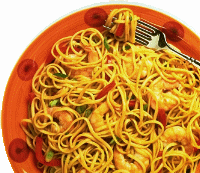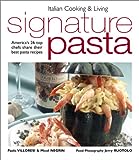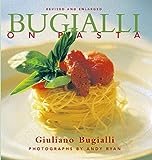how america cooks pasta
the do's and dont's of perfect pasta
by National Pasta Association
(return to food)

|
| pasta do's |
|
Follow the package directions for best results.
Use a large pot (8-quart capacity is ideal) with lots of water - at least 4-6 quarts for every 1 pound of pasta. Add salt, if desired, allowing 1 tablespoon of salt for every pound of pasta.
Use a timer to accurately follow the cooking times called for on the package.
Set your stove temperature high enough to bring the pasta water to a rapid, rolling boil and maintain that boil throughout the entire cooking time.
Stir the pasta when it first goes in the water and occasionally during cooking.
Begin testing for doneness a few minutes before the package directions indicate it will be done. Test by cutting or biting the pasta. If there is a small white dot of uncooked core, the pasta is cooked "al dente," or to the tooth. For softer pasta, wait until there is no white uncooked core showing. If planning to use the cooked pasta in a baked dish, undercook by one-fourth the cooking time.
For hot dishes, add the cooked, drained pasta immediately to the sauce and serve.
|
| pasta dont's |
|
Don't use the directions from one manufacturer for another manufacturer's product since pasta products can vary in size and thickness.
Don't worry about measuring the specific amount of water.
Don't rely on guesswork for the cooking time since it's easy to get sidetracked on other meal preparation tasks.
Don't let the pasta simmer.
Don't rinse the pasta unless you are planning to use it in a cold pasta salad.
|
When it comes to cooking pasta, Americans are rinsers, salters and tasters, according to a new consumer survey conducted on behalf of the National Pasta Association (NPA). "We regularly receive questions from consumers about how to correctly cook pasta so we thought it would be fun to find out how America really cooks one of its favorite foods," commented NPA Chairman Dale Schulz.
Over 600 adults in the United States were interviewed by telephone by Express, TNS Intersearch's Omnibus.
Getting Ready to Cook
When it comes to cooking pasta, slightly more than one-half (58%) of those surveyed reported following the package directions. "This is important," observed culinary expert Leslie Beal Bloom, author of the new cookbook, Seafood Cooking for Dummies, "because the same pasta shapes can vary in thickness and size between manufacturers. Furthermore, each manufacturer tests his own products, so you've got accurate times and information right there."
"Pasta is one of the easiest foods to cook," she added. "By following some simple guidelines, you can ensure perfect pasta every time whether you're cooking a romantic dinner for two, or a welcoming casserole large enough for a group of friends."
Cooking pasta in plenty of water is one key to ensuring perfect results, Bloom said. The vast majority of survey respondents -- 74% -- did report using a 4-6 quart capacity cooking pot or larger. "If you're using a big enough pot, there's a good chance that you're also using enough water," she commented. "Pasta really has to be able to swim so be sure you use 4-6 quarts of water for every pound of dry pasta."
Turn Up the Heat
Another secret to perfect pasta is the cooking temperature - keep the pot at full boil the entire time the pasta is cooking, noted Bloom. In the survey, seven out of 10 respondents (68%) reported setting the stove temperature control or burner at medium high or high when cooking the pasta, and 70.6 % said they left the pot uncovered. "This is great," said Bloom. "What is key," she stressed, "is that the pasta should not be simmered; it needs to be kept at a full boil throughout the cooking process."
To avoid a sticky finished product, Bloom advises bringing the water to a full, rolling boil, and then adding the pasta gradually to maintain the boil as much as possible. Begin timing once all the pasta has been added and the water has returned to a rapid, full boil. Keep the pot uncovered, she added, to prevent your pasta from boiling over.
To Salt or Not to Salt
When cooking pasta, three out of five respondents (61%) said they added salt
to the water. "Adding salt to the cooking water definitely adds flavor
to the finished product," observed Bloom. She recommends using one tablespoon
for each pound of pasta. However, adding salt is optional since sodium
intake may be a health consideration for some people.
If It Sticks to the Wall It's Done, Right?
While survey respondents reported several different ways to tell when the pasta is done, more than one-half (53%) said they taste or bite the pasta. Other popular methods were timing it according to package directions (14%), knowing by instinct or habit (12%), and pinching it (9%). "The old story of throwing pasta on the wall
to see if it's done is fun but it's just that - an old story," said Bloom. "I recommend using a long-handled fork or spoon to pull out a few strands or pieces of pasta, starting several minutes before the package directions indicate it will be done. Then, cut the pasta with a knife or fork, or bite it. Pasta cooked 'al dente,' which means 'to the tooth' in Italian, will be slightly chewy with a very small white dot of uncooked core at the center. For more tender pasta, wait until there is no white uncooked core showing."
The Scoop on Rinsing
Once the pasta is cooked, 54% of survey respondents reported rinsing the pasta, with the majority of those (58%) choosing cold water. The most common reasons given for rinsing the pasta, whether in hot or cold water, were to remove the starch (26%), keep the pasta from sticking together (24%), keep it warm/hot for dishes that are served hot (15%), to cool the pasta/prepare a cold dish (10%), and to stop the cooking process (9%). "These responses indicate to me some challenges on the part of home cooks in handling the finished pasta," observed Bloom. "In fact, rinsing causes the pasta to lose its light starch coating which is actually important in holding the sauce. Plus, rinsing the cooked pasta, whether in cold or hot water, lowers its temperature. This means that even if you're combining it with sauce that's hot, you won't be able to maintain a good serving temperature," she noted. She suggests rinsing pasta only if you're using it in making a salad - and then use cold water to stop the pasta from overcooking.
The first commercial pasta plant in the United States was founded in 1848 in Brooklyn, New York. By the turn of the century, the pasta industry had reached a growth point that triggered a large group of industry members to assemble for a discussion of manufacturing and marketing issues. The result of this meeting was the establishment of the National Macaroni Manufacturers Association. In 1981, the name was changed to the National Pasta Association (NPA). NPA provides leadership to the industry on public policy issues, serving as its voice in Washington, D.C. NPA also forges alliances with key organizations, monitors and addresses technical issues, and organizes events and seminars for the industry.
For more information about U.S. dry pasta, visit the Association's web site at www.ilovepasta.org. Founded in 1904, the National Pasta Association is the trade association representing the U.S. pasta industry.







